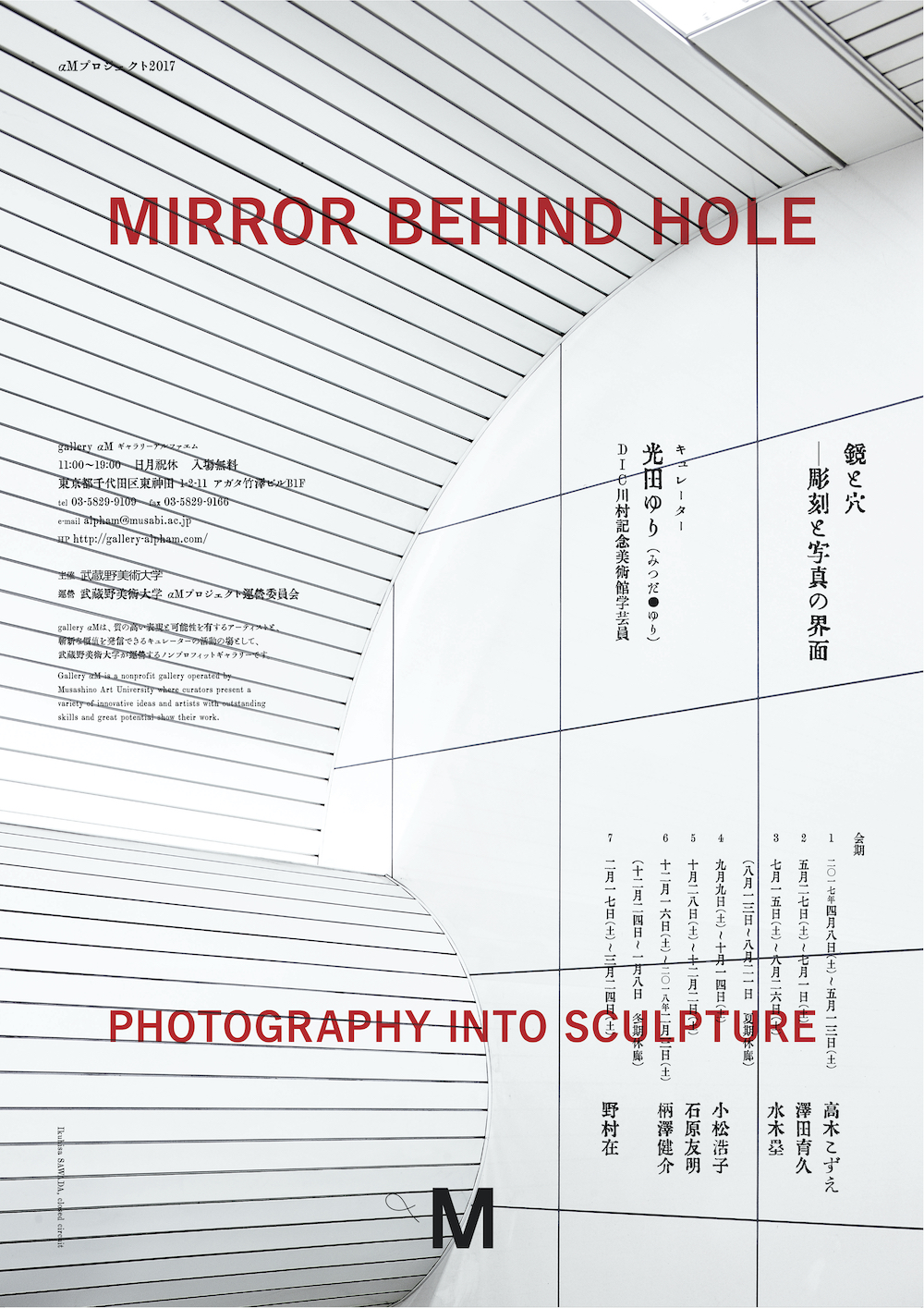- TOP
- >
- αM PROJECT
- >
- αMプロジェクト2017「鏡と穴―彫刻と写真の界面」
αMプロジェクト2017
鏡と穴―彫刻と写真の界面
Mirror Behind Hole Photography into Sculpture

デザイン : 山田拓矢
ゲストキュレーター:光田ゆり(DIC川村記念美術館学芸員、美術評論家)
- vol.1 高木こずえ 2017年4月8日(土)–5月13日(土)
- ・アーティストトーク 高木こずえ×光田ゆり[YouTube]
- vol.2 澤田育久 2017年5月27日(土)–7月1日(土)
- ・アーティストトーク 澤田育久×光田ゆり[YouTube]
- vol.3 水木塁 2017年7月15日(土)–8月26日(土)
- ・アーティストトーク 水木塁×光田ゆり[YouTube]
- vol.4 小松浩子 2017年9月9日(土)–10月14日(土)
- ・アーティストトーク 小松浩子×光田ゆり[YouTube]
- vol.5 石原友明 2017年10月28日(土)–12月2日(土)
- ・アーティストトーク 石原友明×光田ゆり[YouTube]
- vol.6 柄澤健介 2017年12月16日(土)–2018年2月3日(土)
- ・アーティストトーク 柄澤健介×光田ゆり[YouTube]
- vol.7 野村在 2018年2月17日(土)–3月24日(土)
- ・アーティストトーク 野村在×光田ゆり[YouTube]
鏡と穴―彫刻と写真の界面
光田ゆり
デジタルデータが写真である。音楽、文章、グラフィック、映画でもある。統一的に一次元のそれらデータをモニターの外に連れ出そうとするとき、つまり実体物に変換するとき、データは彫刻化される。実体をもたないデータをどのような機材、素材に接続してリアライズさせるか、彫刻化の過程こそ今問われている。
わたしたちがフィルムと古典印画法にこだわり、レコードを収集し、書道を見直し、活版に凝り、国際展で16ミリフィルムのインスタレーションを行うのは、単なるノスタルジーではないだろう。自分たちが物体としての身体を備えている以上、データは彫刻化され触知可能な実体になることが必要だと、気づかされたのである。これまで物体感を見過ごしがちだったレコードや活版は、今となっては圧倒的に彫刻的である。すでに断ち切られた制作の起源を訪ね、かつての彫刻化の技術を学ばねばならない。
写真メディアは実体物をデータ画像に変換する媒介者として、汎用され世に遍在している。そのデータは多様な出力法によりどのようなものにも化身できる。つまりデジタル写真はあらゆる物質の表面上に憑依可能な、【型/mold】としてある。もともと、アナログのフィルムにも【型/mold】の要素はあったのだが、3Dプリンターがデジタルデータをシームレスに彫刻にするにいたり、写真の【型/mold】性は確定されている。
【型/mold】は穴である。そこにどんな物質も受け入れる。一方で写真は鏡だと言われてきた。現実物を写し出して、自らの実体は見せない、反射率100%の鏡だと。今や写真は【型/mold】という穴でもある。実体物の写真像とありもしないものの像をデータ上で区別しない以上、この穴には底がない。反射率0%の穴である。穴と鏡が写真であるとき、そのあいだに彫刻が出現する。
もとより彫刻と写真はつながっていた。絵画の批判に画中画が有効なように、彫刻を批判する彫刻を考えるとしたら、それは写真になる。彫刻メディアを俎上に上げるには、ひとつの彫刻を今ここにある現実性のなかに、特定の場と時間のなかに見なければならない。つまりそれは写真である。彫刻と写真が接続されるとき、伝統彫刻のモニュメンタル性と普遍性のコーティングは剥がれ、傷つきやすくとらえがたい現代彫刻の生な面が露出する。それを支えられるのもまた写真しかない。
そのことを知っていたコンスタンティン・ブランクーシは、アトリエで自分の彫刻群を魅力的な写真にした。ブランクーシはモニュメント以後の、移動可能な彫刻の作家であるから、生きた時間のなか特定の見方ごと自作を提示したかった。彼に見えているとおりの彫刻空間を保存、提示するためには、写真が必要である。空間体験としての彫刻。それはつまり写真なのだ。
ブランクーシはまず石を掘ってかたちのイデアを探す。たどりついたかたちを、ほぼ同寸の数種の石に彫り、ついにブロンズに鋳造する。ブランクーシ彫刻のかたちにとって、素材の交換は可能らしい。かたちのイデアは現実の物質に対して【型/mold】なのだ。その最終形は、石彫から【型/mold】を作ってブロンズ鋳造、鏡面磨き仕上げになる。彼のかたちのイデアは、鏡として実体化する。周囲を映し込む自身の鏡面彫刻を、ブランクーシは鋭い反射光とともに写真に撮っている。その時、彫刻と写真のどちらが鏡だろうか。彫刻のかたちと写真装置のどちらが【型/mold】=穴になるだろうか。
光を反射しない見えない穴と、反射像だけを見せて自身を見せない鏡が、向かい合っている様を思い浮かべたい。現代写真と彫刻のありかをそこに見る試み、今年度のαМ展の基点である。
ゲストキュレーター
▊光田ゆり みつだ・ゆり▊
DIC川村記念美術館学芸員、美術評論家。
兵庫県西宮市生まれ。京都大学文学部卒業。専門は近現代美術史および写真史。
著書に「Words and Things: Jiro Takamatsu and Japanese Art 1961-72」Daiwa Press、2012年、「高松次郎 言葉ともの―日本の現代美術1961-72」水声社、2011年、「写真、芸術との界面に写真史 一九一〇年代―七〇年代」青弓社、2006年(日本写真協会学芸賞)、「「美術批評」誌とその時代」Fuji Xerox Art Bulletin、2006年、「野島康三写真集」赤々舎、2009年。
主な展覧会企画に「美術は語られる ―評論家・中原佑介の眼―」2016年、「The New Word to Come 日本の写真と美術の実験」2015年、「ハイレッドセンター・直接行動の軌跡」2013〜14年、「岡本信治郎 空襲25時」2011年、「野島康三 作品と資料」2009年(美術館連絡協議会優秀カタログ賞)、「中西夏之新作展 絵画の鎖・光の森」2008年、「大辻清司の写真 出会いとコラボレーション」2006年、「安井仲治写真集」共同通信社、2004年(倫雅賞)。
-
English
